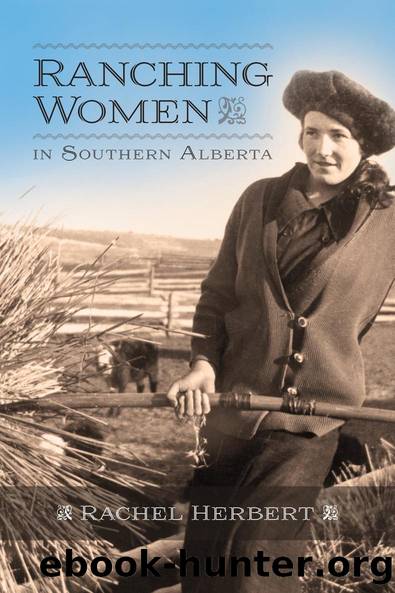Ranching Women in Southern Alberta by Rachel Herbert

Author:Rachel Herbert [Herbert, Rachel]
Language: eng
Format: epub
Tags: Nonfiction, History, Americas, Canada
ISBN: 9781552389140
Publisher: University of Calgary Press
Published: 2017-09-29T04:00:00+00:00
Chapter Five
* * *
Clothing and Saddles: Manifestations of Adaptation
One concrete way to explore how women adapted to life in the West is to examine material artefacts such as clothing and saddles. History has captured the image of the newly arrived English rancher in his tailored suit and necktie topped by a Stetson hat, or wearing his bowler hat with woolly chaps. Less known is how women combined their former ideals of dress with the new realities of ranch life. By examining how women dressed we can see how they employed similar adaptive strategies as their male counterparts while they assimilated cultural components and environmental elements of the Alberta ranching frontier.
The image from Wild West shows of a âcowgirlâ in full, flamboyant western regalia has been popularized more as a way to titillate and entertain than to reflect how women actually dressed. As much as possible the first generation of ranching women attempted to maintain the manners of the Old World through their choice of traditional dress, but out of necessity they made concessions to practicality by gearing themselves appropriately for the range. On most ranches, conservative decorum dictated to some degree what women wore. Late-Victorian and early-Edwardian tradition mandated that women, particularly those from the middle and upper classes, wore a full wardrobe. This costume typically included a corset, bodice, and assortment of petticoats, topped by an ankle-length dress. Often an apron was worn as a protective addition to the ensemble. While this attire was functional for housework and limited barnyard chores, it restricted the work that women could perform with safety and efficiency on the ranch at large. Riding apparel was originally composed of a tailored, tight-fitting jacket, modelled after the corseted bodices of classical Victorian fashion, and a long, very full skirt suitable for keeping a woman modestly covered while riding side-saddle. Even this ensemble, designed for horseback riding, posed limitations on the extent of womenâs activities. The transition to clothes more appropriate to an active ranching lifestyle, replete with rough riding and working with livestock, was gradual. There was no mass revolution in âranch fashionâ; rather, each individual modified her wardrobe as necessary to suit her social position, tastes, and activity level. This fluidity of style makes photographs of ranch women from this period notoriously hard to date, as womenâs style of dress differed from person to person and according to occasion. There was no definitive point when fashions changed. Some women were strictly practical in their choice of attire, as were an American mother and daughter duo who independently ran an enterprising ranching operation south of Moose Jaw. A travelling reporter in 1902 found these ârefined, good lookingâ ladies âdressed in good fitting menâs clothing, and they excused themselves by saying they were doing menâs work and couldnât do it while wearing womenâs clothing.â1 Others preferred to remain more traditionally attired and found ways to modify their feminine wardrobes to suit both function and formality. On most southern Alberta ranches the predominant style of dress was a hybrid of late-Victorian fashion and characteristic western function.
Download
This site does not store any files on its server. We only index and link to content provided by other sites. Please contact the content providers to delete copyright contents if any and email us, we'll remove relevant links or contents immediately.
| Canada | Caribbean & West Indies |
| Central America | Greenland |
| Mexico | Native American |
| South America | United States |
Cat's cradle by Kurt Vonnegut(15251)
Pimp by Iceberg Slim(14433)
4 3 2 1: A Novel by Paul Auster(12328)
Underground: A Human History of the Worlds Beneath Our Feet by Will Hunt(12049)
The Radium Girls by Kate Moore(11967)
Wiseguy by Nicholas Pileggi(5706)
The Fire Next Time by James Baldwin(5379)
Perfect Rhythm by Jae(5354)
American History Stories, Volume III (Yesterday's Classics) by Pratt Mara L(5274)
Paper Towns by Green John(5136)
Pale Blue Dot by Carl Sagan(4949)
A Higher Loyalty: Truth, Lies, and Leadership by James Comey(4903)
The Mayflower and the Pilgrims' New World by Nathaniel Philbrick(4455)
The Doomsday Machine by Daniel Ellsberg(4446)
Killers of the Flower Moon: The Osage Murders and the Birth of the FBI by David Grann(4406)
The Sympathizer by Viet Thanh Nguyen(4336)
Too Much and Not the Mood by Durga Chew-Bose(4301)
The Borden Murders by Sarah Miller(4270)
Sticky Fingers by Joe Hagan(4142)
